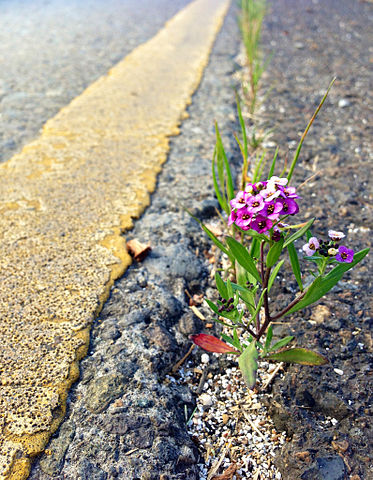Relaxation, peace, and calmness are not goals of mindfulness and meditation practices. They are often common and welcome side-effects, but in a sense they cannot be the desired outcome of practice. The wisdom of this is often hard to grasp from a Western perspective, where relief of pain is an ideal goal of medical treatment. More deeply, contemporary Western culture seems to view a crisis as something to be resolved with urgency and without regard to how the solution might perpetuate a later crisis. When one vein of oil dries up, we dig for another. The suggestion that we slow down, sink into the crisis, and let it transform our way of life so that it is not longer a crisis is antithetical to how we do life.
Often, when I lead someone in meditation or mindfulness practice for their first time, they will report a feeling of calm and serenity. This was my early experience as well. I remember that I had meditated daily for about three months when, one morning, I suddenly realized that the muscles in my legs were tense. I realized, furthermore, that they were often tense. I realized, further-furthermore, that I could simply allow them to relax and there was no more tension. I had no idea of any of this because I’d spent very little of my life being present to my body. I spent much more time avoiding my body and all its “undesirable” sensations.

My theory, which is not so much “mine” as it is one I’ve discerned from encountering Buddhist thought, Western Esoteric thought, and a lot of psychology books, is that one underlying source of tension arises from all the ways we humans avoid the experiences we label as bad or undesirable. It is like when one has a broken toe and learns how to limp to reduce the intensity of pain in the toe. With time, that person might begin to notice pain and tension in their upper back, their neck, their other leg. The body has an optimal way to move, and any variations on that movement has a longer-term cost.
So too, I think, with the mind. If I’m trying not to feel sad, not to feel vulnerable, not to feel angry, not to feel hopeful, not to look bad in front of others, not to feel too anxious, not to feel lonely, not to feel hopeless, not to feel ugly, not to feel desired, not to feel criticized, not to stand out too much, not to feel scared… There is a wide array of undesirable experiences and one person’s heaven is another’s hell. But if we are whole people, then there will be moments when we’ll have these feelings and more. And when someone says, “I don’t want to feel this way,” I often hear, “Part of me feels this way and another part of me is trying to push it down.” This inner conflict creates tension and dis-ease.
Meditation is the antidote to this, as it cultivates unconditional acceptance. Often there is an object or focus of meditation, but quickly we learn how much the wind wanders from the object of attention. The practice is to learn to notice when the attention has shifted and gently bring it back to the object of focus. Simple but not easy. When we sit in stillness, often we encounter everything unresolved in our hearts and minds, all of our habits of being, all of our tensions, essentially everything that we want to avoid noticing. The more that we can accept these as simply being there and gently return to the present moment through bringing attention to the object of focus.
Often, after doing this for the first time, many people report feelings of relaxation or tiredness. I think that comes from the ease of being present and not constantly striving to avoid one thing or pull toward another. Discomfort is simply discomfort and not something to rail and struggle against. Hence the benefits of ease. The problem comes when someone go back to meditation hoping to get back to that relaxation. Now they’re stuck avoiding some feelings and trying to grab others. They want a specific outcome and push away all the experiences that aren’t that outcome. Even this is great information, illuminating yet another habit of thought and being that one can approach with acceptance.
That is what is meant when someone refers to happiness as a trap. If all we’re concerned with is preserving things as they are and dismissing anything that doesn’t fit the experience we want to have, we’re stuck. If we only choose to listen to some opinions, look at some information, acknowledge some problems and condemn the rest, we’re stuck. Acknowledging more of the wholeness of experience gives our knowledge, wisdom, and ideas more depth and integrity.







 Duality is useful but false when taken too literally. In truth, the multiplicity of options before us is so vast that thinking too much can overwhelm us. Reducing things to two polarized possibilities can help to focus our thinking, but it becomes limiting when we try to make one option “win” over the other. If two ends of a polarity pull on us, then certain aspects of ourselves have attached to either end, and to choose one at the cost of the other is difficult and self-defeating.
Duality is useful but false when taken too literally. In truth, the multiplicity of options before us is so vast that thinking too much can overwhelm us. Reducing things to two polarized possibilities can help to focus our thinking, but it becomes limiting when we try to make one option “win” over the other. If two ends of a polarity pull on us, then certain aspects of ourselves have attached to either end, and to choose one at the cost of the other is difficult and self-defeating.

 Failure shows us a truth about ourselves we would never otherwise see. Feeling discouraged, hurt, and disappointed is hard. We might want to ignore it and punish ourselves by working twice as hard. We might want to numb out and detach. If I can sit with the discomfort for even a moment, allow the hurt to just be, then I pull that energy back into the shifting movements of life. The lessons flow into the next act. Perhaps I do not go back to gardening immediately. Perhaps I start smaller, with potted plants. Perhaps I go seek some teaching. Perhaps I spend the winter knitting.
Failure shows us a truth about ourselves we would never otherwise see. Feeling discouraged, hurt, and disappointed is hard. We might want to ignore it and punish ourselves by working twice as hard. We might want to numb out and detach. If I can sit with the discomfort for even a moment, allow the hurt to just be, then I pull that energy back into the shifting movements of life. The lessons flow into the next act. Perhaps I do not go back to gardening immediately. Perhaps I start smaller, with potted plants. Perhaps I go seek some teaching. Perhaps I spend the winter knitting.